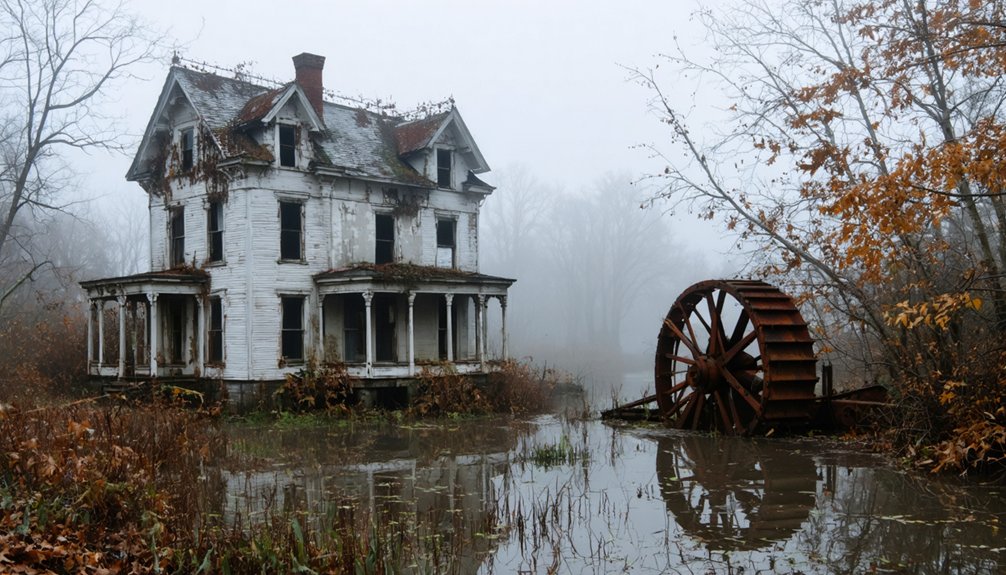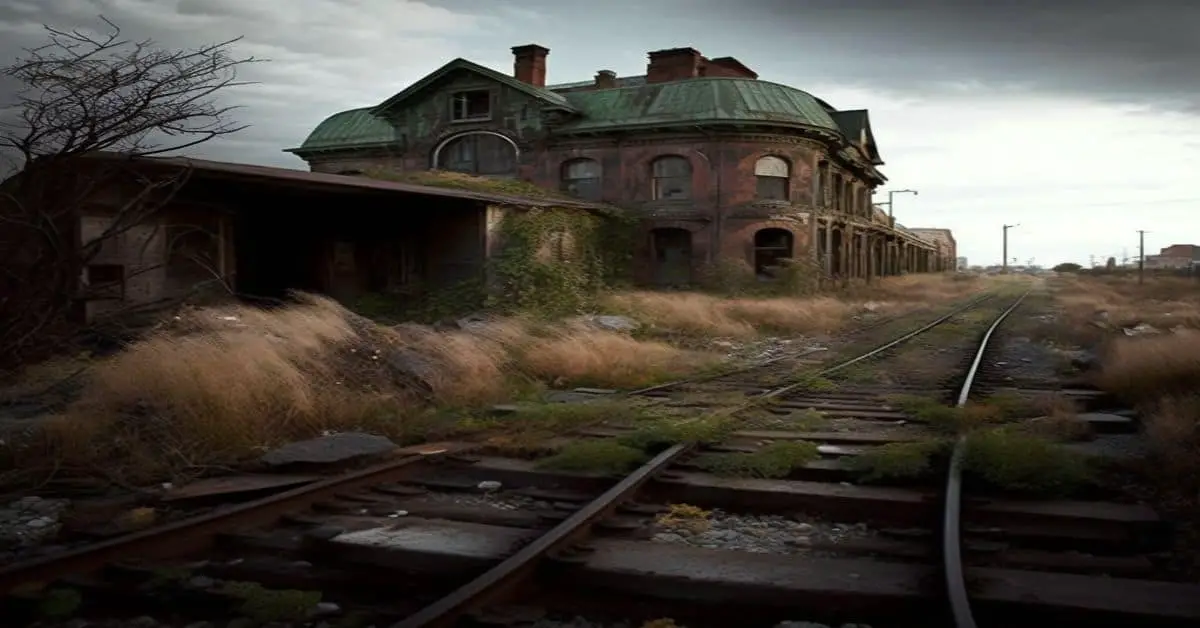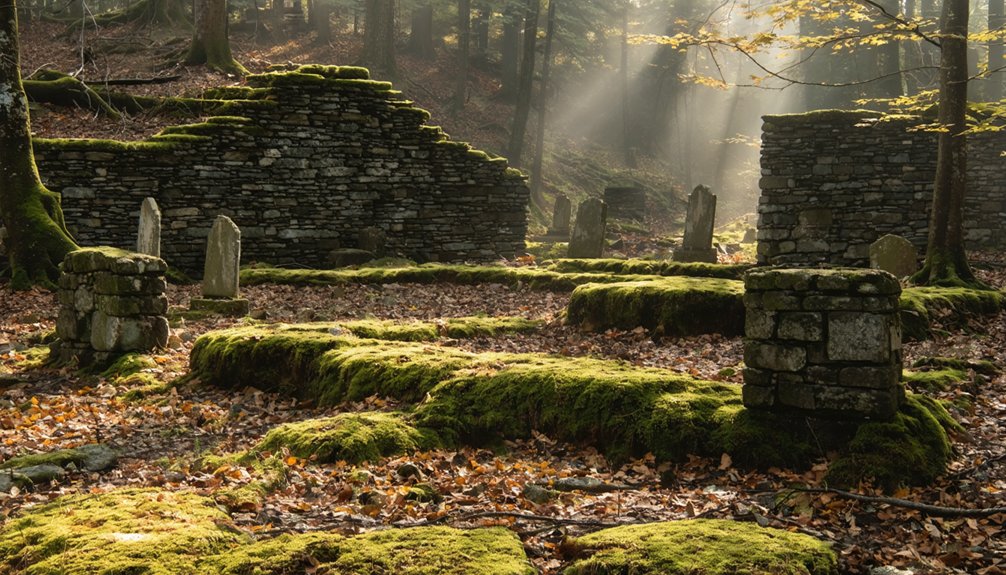You’ll find Johnsonville Village in East Haddam, Connecticut, where abandoned Victorian buildings and mill ruins showcase a once-bustling 19th-century twine manufacturing hub. After fires destroyed key mills and synthetic fibers reduced demand, the village declined until Raymond Schmitt purchased it in 1965, transforming it into a Victorian tourist attraction. Though his dream ended with his death in 1998, the village’s latest chapter began in 2017 when Iglesia Ni Cristo acquired the property, promising new life for these historic grounds.
Key Takeaways
- Johnsonville Village transformed from a thriving 19th-century mill town into an abandoned ghost town following devastating fires and industry decline.
- Raymond Schmitt purchased the village in 1965, attempting to create a Victorian tourist attraction before his death ended the project.
- The village’s industrial decline began with the Triton Mill fire in 1924 and continued through Neptune Mill’s destruction in 1972.
- The abandoned village became known for reported paranormal activity and served as a filming location for music videos and movies.
- Iglesia Ni Cristo bought the ghost town in 2017 for $1.85 million, initiating restoration efforts to transform it into a religious center.
Rise and Fall of a Mill Village
While many New England mill towns faded into obscurity, Johnsonville’s rise and fall stands as a particularly dramatic example of industrial transformation in the region.
You’ll find its origins in the early 19th century, when entrepreneurs harnessed the Moodus and Salmon rivers’ power for twine production. The village’s industrial heritage flourished with the construction of the Neptune Mill in 1832 and the Triton Mill in 1862, spawning a 62-acre community devoted to mill production. The mills maintained raw cotton warehouses near their operations to ensure production could continue through winter months when deliveries were difficult.
At its peak, Johnsonville operated 12 mills, supplying fishnets nationwide and supporting both World Wars. The area became known as center of twine production in Connecticut.
But fires proved devastating – the Triton Mill burned in 1924, Falls Mill in 1943, and finally, lightning struck the Neptune Mill in 1972.
These disasters, coupled with industrial obsolescence, transformed this once-thriving manufacturing hub into a ghost town.
Schmitt’s Vision of a Victorian Tourist Haven
After acquiring Johnsonville Village in 1965, retired aerospace manufacturer Raymond Schmitt commenced on an ambitious mission to transform the abandoned mill town into a Victorian-era tourist destination.
You’d have found his passion for Victorian authenticity reflected in every detail, from the carefully transported historic buildings to the period-appropriate furnishings throughout the village.
Schmitt’s vision included relocating several landmark structures: a Victorian stable, chapel, Quaker meetinghouse, general store, and schoolhouse.
He even installed “The Canadian,” a sternwheeler paddleboat, on the millpond to enhance the 19th-century atmosphere.
The property, spanning 62 scenic acres, offered ample space for Schmitt’s expansive restoration plans.
After his death in 1998, the property was sold to a hotel development group, marking the end of his Victorian revival dream.
While the tourist attraction never achieved commercial success, largely due to zoning disputes and the devastating 1972 fire that destroyed Neptune Mill, Schmitt’s preservation efforts left an enduring legacy that captured public imagination, even serving as the backdrop for Billy Joel’s “The River of Dreams” music video.
From Industrial Power to Abandoned Streets
Before its decline into abandonment, Johnsonville thrived as a bustling industrial center powered by the rushing waters of the Moodus River.
As you explore the village’s industrial heritage, you’ll discover how this once-prosperous community transformed from an essential manufacturing hub into a silent ghost town.
The story of Johnsonville’s community decline unfolds through these pivotal events:
- The Triton Mill’s destruction by fire in 1924 marked the first major blow to local industry.
- Neptune Mill’s construction briefly revived hope until its fiery demise in 1972.
- The rise of synthetic fibers like nylon drastically reduced demand for traditional twine.
- Manufacturing jobs disappeared, causing residents to seek opportunities elsewhere.
Today, you’ll find empty streets where workers once hurried to their shifts, and silent mill buildings that once hummed with activity. In 2017, the abandoned property sold for $1.85 million after years of being on and off the market. Raymond Schmitt transformed the area into a Victorian Era attraction during the 1960s, hoping to preserve its historical charm.
Ghostly Tales and Pop Culture Fame
Since its abandonment, Johnsonville has carved out a unique place in popular culture as both a hauntingly beautiful film location and a magnet for paranormal enthusiasts.
You’ll spot its Victorian architecture in Billy Joel’s “River of Dreams” music video and the 2014 films “Freedom” and “Deep in the Darkness,” where its ghostly atmosphere takes center stage.
Local legends tell of ghost sightings and paranormal encounters by trespassers, dubbed “ghost gangs” by frustrated nearby residents.
While no official studies confirm these haunting claims, the village’s skeletal animal remains and frozen-in-time appearance fuel supernatural speculation.
The failed tourist attraction, carefully curated with relocated historic buildings by owner Raymond Schmitt, now stands as a symbol of unfulfilled dreams, drawing both filmmakers and thrill-seekers to its decaying grounds. A security guard patrols the property to manage increasing incidents of trespassing since the 2014 auction.
The dramatic destruction of the historic Neptune Mill by lightning in 1972 only added to the village’s mystique and air of tragedy.
New Chapter Under Iglesia Ni Cristo
The haunting tales and eerie atmosphere of Johnsonville took an unexpected turn when Iglesia Ni Cristo (INC) purchased the 62-acre ghost town in June 2017 for $1.85 million.
The Philippine-based church swiftly transformed the abandoned village into a vibrant religious center, focusing on architectural preservation while adapting historic structures for modern use. The church’s presence marks another milestone in its mission to establish churches in 110 countries. Local residents and community leaders expressed strong enthusiasm about the purchase and the potential for revival.
Through community engagement, INC has breathed new life into this once-forgotten corner of Connecticut:
- Restored the historic chapel as an active house of worship
- Established a regional hub for Northeast congregations
- Hosts large-scale events like the Worldwide Walk Campaign
- Provides ministerial training facilities
You’ll find the village’s revival has been welcomed by East Haddam residents, who’ve long hoped to see Johnsonville’s historic buildings rescued from decades of neglect.
Frequently Asked Questions
What Happened to the Johnson Family After the Mills Closed?
You won’t find records of the Johnson family’s activities post-closure, as they disappeared from public documentation after selling their remaining properties to Raymond Schmitt in 1965, ending their century-long connection to Johnsonville.
Are There Any Original Artifacts From the Mills Still Preserved?
You’ll find some preserved artifacts like historical documents, business cards, and advertisements in local collections, while physical mill remains include dam structures and turbines, though most large machinery is lost.
How Many Workers Were Employed During Johnsonville’s Industrial Peak?
While exact numbers aren’t documented, you can estimate several hundred workers at peak operations based on similar Connecticut mill towns’ worker demographics, though employment steadily faced industrial decline until the 1972 closure.
What Specific Products Did the Neptune Mill Manufacture Besides Twine?
You’ll find Neptune Mill’s industrial diversification included stocking yarn for textiles and hosiery, carpet warp for weaving, cord wrapping materials, and various yarns produced continuously from 1832 to 1900.
Did Any Other Businesses Operate in Johnsonville Besides the Mills?
You’ll find The Card Company shared space in Neptune Mill, but beyond the mill operations, Johnsonville’s history shows limited business diversity, reflecting the industrial decline that eventually emptied this once-bustling community.
References
- https://i95rock.com/the-abandoned-ghost-town-of-johnsonville-ct-then-now/
- https://www.vice.com/en/article/inside-johnsonville-the-victorian-ghost-town-that-no-one-wants-922/
- https://www.cbsnews.com/media/own-the-historic-ghost-town-of-johnsonville/
- https://www.atlasobscura.com/places/johnsonville-village
- https://www.onlyinyourstate.com/state-pride/connecticut/johnsonville-ct
- https://www.youtube.com/watch?v=vFRKgaXHLy4
- https://www.williampitt.com/johnsonville-connecticuts-hauntingly-beautiful-ghost-town/
- http://www.ddtvl.com/johnsonville.htm
- https://johnsonville.omeka.net/exhibits/show/tour/johnsonvilleroad/mill
- https://www.easthaddamstories.org/mills



